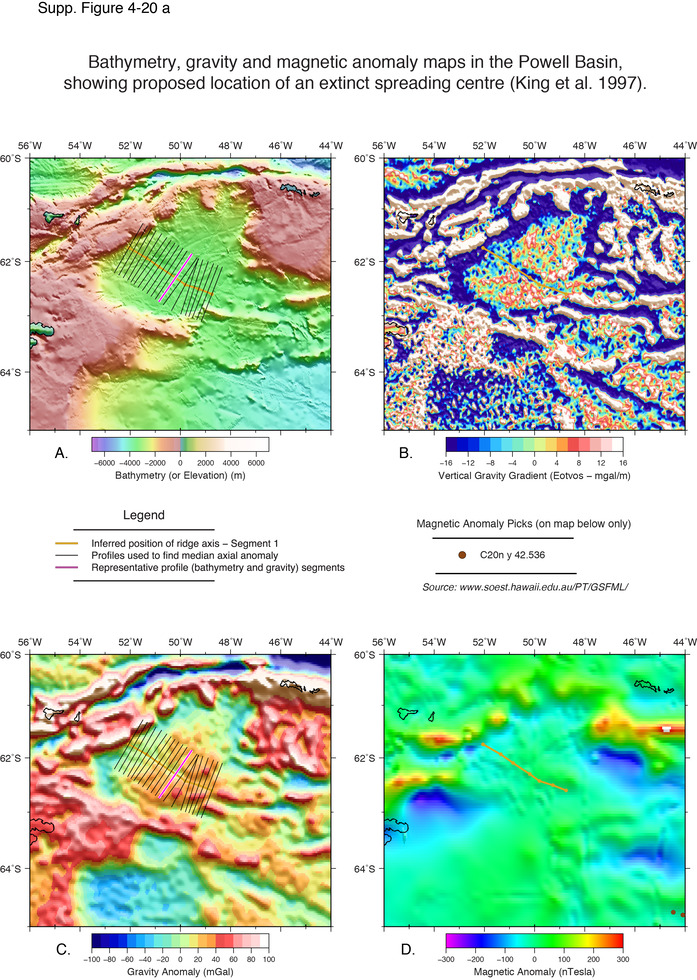| Ocean: | Marginal basin |
| Spreading center type: | Large-scale extinct MOR |
| Time of cessation: | Proposed as 23 Ma (King and Barker, 1988) or 21.8, chron C6AA (Eagles and Livermore, 2002) |
| Subsequent active spreading center: | (?) Jane Basin BAB spreading center |
| Cessation style: | Some studies suggest a protracted slow-down (Coren et al. 1997) |
| Later deformation or volcanism: | None evident |
King et al. (1997) reported an extinct spreading axis in the Powell Basin, from seismic refraction sections calibrated with seismic reflection data that imaged an axial valley coincident with a negative gravity anomaly of low-magnitude. They inferred that the basin had formed by a SW-NE oriented spreading center and traced the position of the suspected axis, providing a reconstruction for the opening of the basin at around 29 Ma (King et al., 1997). Magnetic anomalies could not be resolved from data available at the time of their survey.
This age was compatible with that derived from age-depth relationships corrected for heat-flow that give a probable age of formation 37 - 23 Ma (King and Barker, 1988), and the late Oligocene formation age proposed by Howe et al. (1998). However, it has been demonstrated that back-arc basins may subside at a faster rate than larger basins (Park et al., 1990) and slightly younger ages have been suggested by some later authors. Eagles and Livermore (2002) reviewed geophysical data from the Powell Basin and infer that an observed 20-mGal gravity low feature represents the extinct ridge and interpret aeromagnetic data to infer anomalies C11 (29.7 Ma) to C6AA (21.8), with spreading rate decreasing from 16.5 to 8 km/Myr.
An alternative interpretation of basin history was made from identification of magnetic anomalies within the basin (Coren et al., 1997) and the structural bounds of sedimentary sequences within the basin that inferred a more complex history. Coren et al. (1997) suggested that at least two phases of rifting have occurred within the basin. They argue that initial rifting with extension of around 60 km occurred before 27 Ma, after which oceanic spreading occurred until 18 Ma in the north of the basin. They suggest that the final phase of SW-NE spreading from 18 Ma to the early Pliocene in the southern Powell Basin occurred due to rotation of the South Orkney Microcontinent.
A regional change in the direction of relative motion between Antarctica and the South American Plate is attributed to be the cause of cessation of spreading within the Powell Basin (Eagles and Livermore, 2002).
Similarly to previous studies our review has demonstrated that there is limited bathymetric expression of an extinct ridge with relief changing by less than 50 m over the central part of the basin, but a characteristic negative gravity anomaly is displayed at the inferred extinct spreading center axis.
Coren, F., Ceccone, G., Lodolo, E., Zanolla, C., Zitellini, N., Bonazzi, C. and Centonze, J., 1997, Morphology, seismic structure and tectonic development of the Powell Basin, Antarctica. Journal of the Geological Society, v. 154, no. 5, p. 849–862.
Eagles, G. and Livermore, R. A., 2002, Opening history of Powell Basin, Antarctic Peninsula, Marine Geology, v. 185, no. 3-4, p. 195–205.
Howe, J. A., Livermore, R. A. and Maldonado, A., 1998, Mudwave activity and current-controlled sedimentation in Powell Basin, northern Weddell Sea, Antarctica. Marine Geology, v. 149, no. 1-4, p. 229–241.
King, E.C. and Barker, P.F., 1988, The margins of the South Orkney microcontinent, Journal of the Geological Society, v. 145, no. 2, p. 317–331.
King, E.C., Leitchenkov, G., Galindo‐Zaldivar, J., Maldonado, A. and Lodolo, E., 1997, Crustal structure and sedimentation in Powell Basin, Geology and Seismic Stratigraphy of the Antarctic Margin, v. 71, Part 2, p. 75–93.
Park, C.-H., Tamaki, K. and Kobayashi, K., 1990, Age-depth correlation of the Philippine Sea back-arc basins and other marginal basins in the world. Tectonophysics, v. 181, no. 1-4, p. 351–371.


